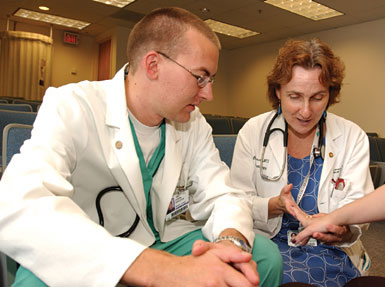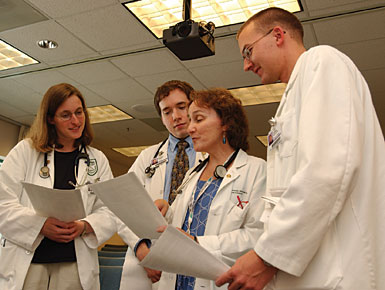Dartmouth-Hitchcock Medical Center Development
The value of clinical teaching
By Barbra Alan
You don't have to be a fan of Star Trek to cringe when you hear the series's resident Vulcan referred to as Dr. Spock. To be sure, actor Leonard Nimoy plays the role of Mr. Spock with intelligence, logic, and grace under pressure—all qualities that are associated with the medical profession.
But it takes more than knowledge and composure to be a good doctor. It also requires humanism: the ability to treat the person, not just the disease, and to do so with kindness and compassion.
Clinical education matters
Just as skill is crucial to the practice of medicine, so, too, is sensitivity crucial to the healing of the patient. Through structured learning experiences with patients, medical students develop the qualities of the humane caregiver: empathy, excellent communication skills, and respect for the patient-physician relationship.
It is this relationship that teaches students the invaluable lessons of life, health, illness, and even death that will help them to become empathetic as well as erudite practitioners. Such lessons can't be learned in a classroom or even during a quick, 10-minute office visit.
"For me, the most useful aspects of the clinical experience are learning and practicing my approach to both the patient and the illness," explains Joren Keylock, now a fourthyear medical student. "These skills are incredibly important and are practiced in every clinical rotation."
Like Keylock, all medical students at Dartmouth participate in clinical rotations, also known as "clerkships." Clerkships give students the opportunity to train with physician mentors in both outpatient and inpatient settings.
DMS students complete clerkships in various core specialties, as well as in whatever elective disciplines they choose, so they can experience the vibrancy and variety of caring for the sick and supporting the healthy. To ensure that students are exposed to different patient populations and methods of practice, clerkships are carried out at the DHMC campus in Lebanon, N.H., at the VA Medical Center in White River Junction, Vt., and at a number of other inpatient and ambulatory settings throughout the country.
The faculty physician, or "preceptor," is the student's most important ally on the journey toward becoming a doctor. These special alliances can last for a lifetime and often inspire tomorrow's doctors to later take students under their own wings.
But the opportunity to nurture such a relationship—through impromptu hallway conferences, brief brainstorming sessions, and day-today mentoring—is increasingly being endangered by the need for faculty to sustain clinical productivity so that the institution's bottom line is not jeopardized.
Clerkships provide students with essential hands-on experience in history-taking, examining patients, and ordering diagnostic tests, as well as in performing basic medical procedures such as drawing blood, inserting intravenous lines, and taking blood-gas samples. Students also benefit from observing the body language and bedside manner of experienced practitioners on the faculty.
|
"When students join faculty on rounds," says Lin Brown, M.D., an associate professor of medicine at DMS, "they observe a variety of styles of problem-solving, dealing with patients, and professional behavior and then determine what's comfortable for them." Brown, a rheumatologist, is director of the inpatient medicine clerkship and teaches rheumatology fellows as well as medical students.
A matter of time
But ever-growing fiscal concerns, and associated time constraints, are jeopardizing the quality of students' clinical learning at medical centers across the nation. In today's costconscious environment, most managed- care companies reimburse academic medical centers no differently than they do for-profit hospitals or non-teaching community hospitals. This is in spite of the fact that teaching hospitals handle a higher percentage of complex conditions, calling for more expensive equipment and more highly trained staff, and also provide a far higher percentage of the nation's unreimbursed charity care.
Additionally, reimbursements from government programs such as Medicare and Medicaid have declined in recent years, adding to hospitals' financial burden. As a result, America's health-care providers are being pressed by their employers to work more efficiently. But it's important not to lose sight of the importance of teaching.
"Doctors are facing pressures to see more patients, to be more productive, and to fill any holes in their schedules," explains Brown. "The more patients you see and the more tests you order, the more money you make [for the institution]—which is more valuable than teaching in a feefor- service economy."
These productivity demands are forcing some of the nation's physician- teachers to pare back their teaching so they can see more patients. Throughout the country, declining fees have even prompted some doctors to shorten their time with patients and squeeze more appointments into a day.

|

|

|
|
Clinical teaching is a complex and people-intensive process. Top: Rheumatologist Lin Brown (left) meets with third-year medical student Joren Keylock to discuss a patient they're about to see. Middle: Then Brown shows Keylock how to perform a routine exam. Bottom: Later, she reviews the day's cases with Keylock (right) and two other third-year students, Leigh Strauss (left) and Mike Leslie. |
|
All photos: Flying Squirrel Graphics |
Meeting the challenge
The challenge of maintaining the capacity to teach in clinical settings, and to teach well, faces all academic medical centers today. When students must train with physician-teachers who have too-hectic schedules, not only is the quality of patient care compromised, but so is the quality of clinical learning. Dartmouth Medical School and Dartmouth- Hitchcock Medical Center are committed to sustaining clinical teaching experiences, to making continuous improvements in their quality, and to guaranteeing their continuance into the future.
One way to do this is through the funding of clinical teaching endowments. Such endowments give faculty physicians the time they need to provide both exceptional patient care and superior training of the medical students who represent the future of medicine.
Dr. Brown is just one of the many dedicated faculty members at Dartmouth who understand the value of the teaching function at DMS. "I'm lucky that some of my time is protected to teach," she says. "Giving faculty adequate time and support to teach is absolutely critical."
Learn to see, learn to hear, learn to feel, learn to smell, and
know by practice alone you can become expert. Medicine is
learned by the bedside and not in the classroom.
— Sir William Osler
Partners in teaching
Continued cuts in funding for teaching hospitals nationwide threaten all aspects of the healthcare system, since clinical education occurs primarily in teaching hospitals. Medical education touches all of society, providing the rigorous learning opportunities and supervised, real-world training that are essential in preparing physicians for practice.
Our nation's health-care system relies on teaching hospitals like DHMC for the clinical education of its future doctors. Not only do teaching hospitals provide primary care and routine patient services, but they are centers for investigational and technically advanced services. These institutions are also the training ground for physicians and other health professionals, as well as the principal source of innovative therapies, surgeries, and technologies to treat and cure complex conditions. Moreover, they offer a disproportionate amount of the nation's care for underserved populations.
To compensate for the inadequacy of federal and state support for clinical teaching, private philanthropy is critical. Philanthropic endowments such as DHMC's Thomas Almy Clinical Scholars Fund; Thomas Chalmers Community Teacher Fund; and William Chambers Community Faculty Award help the institution sustain its clinical teaching excellence. Funds such as these support faculty salaries, underwrite faculty members' time for clinical teaching, and allow faculty to develop new clinical teaching programs.
Now more than ever, DHMC depends on the generosity of those who understand the importance of clinical teaching and are inspired to support it. The quality of the medical education for today's students will determine the quality of care for tomorrow's patients.
Barbra Alan is assistant director of development communications at DHMC.
If you would like to offer any feedback about this article, we would welcome getting your comments at DartMed@Dartmouth.edu.
